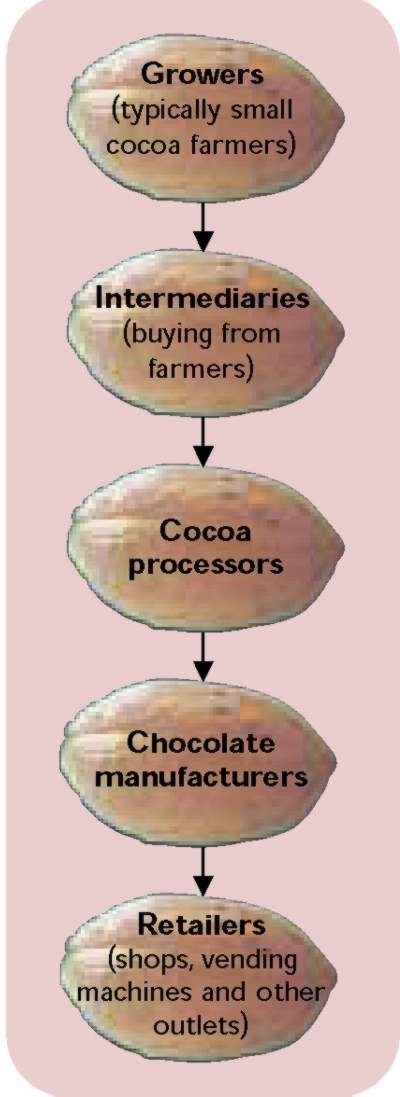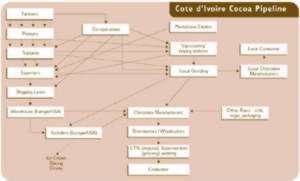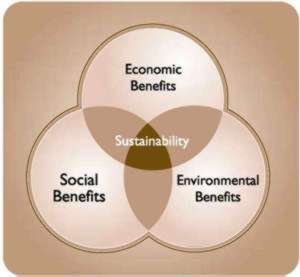Whenever market researchers report on UK consumers’ favourite purchases, chocolate-based products feature strongly. Chocolate is a key ingredient of many products we enjoy e.g. hot drinks, biscuit snacks, cakes, and confectionery.

To make their products, chocolate manufacturers use recipes that rely heavily on cocoa beans. Cocoa liquor and cocoa butter come from cocoa beans. Chocolate manufacturers buy the cocoa beans, liquor and butter they need on world markets.
Chocolate production and manufacture is a worldwide industry with some interesting characteristics.
- Most chocolate products are eaten far away from where cocoa is grown.
- Cocoa is grown in a small number of tropical countries,which depend heavily on successful production of cocoa to sustain their economies.
- From cocoa bean to finished chocolate product is a long and complex process which raises the question of how all involved in the industry can benefit from the financial returns in a way that is fair to everyone who contributes at the various stages.
The major manufacturing companies in the UK are members of the BCCCA: the Biscuit, Cake, Chocolate and Confectionery Association. Based in London, the BCCCA provides a common voice through which UK chocolate manufacturers can express their views. It also enables co-operation between companies on non-competitive issues. One task for BCCCA members is to decide how best to create a sustainable chocolate industry that offers:
- a continual improvement in the quality of chocolate products
- a fair standard of living for cocoa growers
- steady business growth for manufacturing companies.
The world market for cocoa

Much of the world’s cocoa comes from West Africa, which provides 70% of total output. The two main suppliers are the Cote d’lvoire and Ghana. In these countries, the cocoa beans are typically grown on small family farms. Most of these are only two to three hectares in size. Each farm produces around one tonne of beans each year.
Chocolate manufacturers recognise that the small growers are the industry’s lifeblood, and that our enjoyment of chocolate products depends on their wellbeing. So, the industry is working with other organisations on the ground in West Africa on a series of programmes designed to improve the economic and social well-being of the cocoa farming villages and to ensure that small farmers secure a sustainable future.
Although some finished chocolate products will be consumed close to local production (e.g. in West Africa), far larger quantities are consumed elsewhere. Farmers grow around three million tonnes of cocoa beans each year. Of these, about 700,000 tonnes go to the USA. UK manufacturers import about 215,000 tonnes.

Demand for chocolate products drives the supply of cocoa. Without willing consumers to sell to, there is no point or profit in producing. Consumers, manufacturers and suppliers all rely on each other. If cocoa growers are to stay in business, manufacturers that use cocoa must do more than offer them fair prices. They must also ensure that the global market for chocolate-based products remains buoyant and growing.
Developed countries are the major consumers of the world’s cocoa supply. However, they are mature markets and new growth is likely to come from countries such as China. There, rising living standards and growing familiarity with chocolate products are causing a rapid increase in consumption. For the industry to prosper, it is vital to put time and effort into marketing.
The supply chain for chocolate

As with many other manufacturing industries, creating chocolate products involves a chain of production with many links.
It starts with cocoa bean growers and ends when retailers sell us the final product. This may be in a small shop, supermarket, vending machine or some other retail outlet. Some obvious links in this chain are shown in the diagram.
At each stage of the chain there will be additional services that help producers to operate more effectively. These include banking and insurance services, packaging firms, transport specialists.
The supply is actually far more complex than the simple diagram suggests. The illustration shows the complexity of the cocoa supply chain in the Cote d’lvoire.

It is clear that in the course of converting cocoa beans into cocoa butter the raw material will be traded several times. Only after that will UK and other manufacturers purchase the cocoa beans and cocoa butter for final processing.
In countries like Ghana, where the Government regulates the market, the price paid to farmers is fixed and they use established local buying stations. In contrast, in the Cote d’lvoire the farmer’s product will move along the supply chain to the end consumer in several ways; usually a local agent may approach the grower and offer a deal.
Working towards sustainability
A sustainable business is one, which is committed to helping meet the needs of society today, while respecting the needs of future generations. In promoting ‘sustainability’, the chocolate industry wants to see growth and improvement in:
- the quantity and quality of the product
- the standard of living enjoyed by growers.
Both of these contribute to a healthy cocoa industry from which all involved can benefit.
Chocolate manufacturers have a key role to play in this process by seeking to ensure that:
- Demand is sustainable by working to improve chocolate quality and through marketing activities.
- Supply is sustainable by helping growers receive a fair price and increase cocoa yields.
Chocolate manufacturers work to ensure the quality and reputation of chocolate products. They use market research and other marketing techniques to meet customers’ demands for an increasing variety of products. Manufacturers constantly introduce new chocolate products, e.g. ice cream chocolate bars, ready-made desserts.

At the same time, chocolate manufacturers work in partnership with growers and with the cocoa-producing countries to empower the grower. Current projects include:
- providing market information processes, such as information on world cocoa prices and timing of sales
- supporting growers in developing better farming techniques and practices.
To maintain a sustainable industry, it is vital to be fair to the grower, the first link in the chain. Fairness involves encouraging a reasonable living for growers and their families. More than 10 million people live on cocoa farms in parts of the world that offer a warm, wet environment which is ideal for growing cocoa. These lie in a band near the equator.
Cocoa is a very important industry for some countries. For example, in the Cote d’lvoire, the world’s largest grower of cocoa beans, cocoa growing provides over 50 of total household income. Almost all the farms are small. Typically, farms consist of a smallholding of cocoa plants, which are surrounded by other types of tropical trees that provide the necessary shade.
Cocoa production is not suitable for a large scale, exclusive approach. This is because a monoculture runs too high a risk of spreading disease that could wipe out the industry. By promoting biodiversity, cocoa growing contributes to the global environment and to local development.
Chocolate manufacturers support fair prices for growers. A market which operates on the basis of very low prices for cocoa, puts at risk the sustainability of cocoa growing. This is because most cocoa producers have some choice over what they grow. For example, a cocoa farmer who cannot make a living from growing cocoa may switch to producing palm oil.
So, the chocolate industry worldwide supports several initiatives aimed at achieving better prices for cocoa growers.
These include:
- Market information systems. Unlike many other crops, growers are able to store mature cocoa beans for up to a month. As a result, the grower does not necessarily have to sell to the first potential buyer. However, small farmers in remote areas of the Cote d’lvoire find themselves at a disadvantage compared with other growers. Because of their remote location they will have fewer opportunities available to them. They usually do not have Internet access and often lack key market information. The chocolate industry is providing data on current market prices to growers through Field Training Officers, and via newsletters. Armed with this data, together with advice and training, the grower is better placed to negotiate a fair trading price.
- Research. When cocoa growers produce a better yield of high quality cocoa beans, everyone benefits. The chocolate industry funds research into improving agricultural techniques and approaches. This has provided treatments for cocoa plant pests and diseases such as the Cocoa Pod Borer. Without support, farming families can lose well over a third of their crops each year from disease and pests.
- Training. The industry also funds a range of Field Schools for cocoa growers in Africa. These schools show farmers how to improve their production methods. This includes pruning dead cocoa pods; weeding around plants; planting suitable native trees alongside their cocoa. The schools cover other vital aspects too e.g. business management techniques; fair and proper treatment of workers.
The benefits of sustainability

To be truly sustainable, the chocolate industry’s supply chain initiatives focus on 3 key areas.
Helping cocoa growers to be better informed creates:
- economic benefits – better returns for growers and chocolate manufacturers. Higher Gross Domestic Product for the countries in which cocoa is grown.
- environmental benefits – encouragement of bio-diversity because cocoa growing does not involve plantation-type agriculture, and helps the proliferation of species.
- social benefits – valued, traditional ways of life are sustained but in a way that fosters better economic returns for the cocoa farmers, their families and communities.
Conclusion

For nearly every industry, sustainability is a key objective. Creating a sustainable chocolate industry benefits all of the industry’s stakeholders, from the grower to the manufacturer.
The chocolate industry is working with relevant partners to create a sustainable future. By co-operating in this way, it is possible to improve the sustainability of the industry: better working conditions on farms; better quality cocoa; fair prices for all contributors; superior and more varied chocolate; more satisfied customers.
